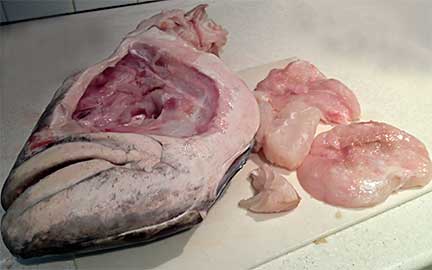
Fish Stock
Yield varies depending on pot size
Halibut and rockfish are my favorite fish to use for making fish stock, a very convenient ingredient to keep in the freezer for all seafood-based sauces, soups, and stews. During Alaska summers, halibut heads and racks are readily available on the docks in fishing communities, where they’re usually thrown in dumpsters or in the water for seals and gulls. I beg my fishing friends to bring me them for fish stock, which I make in bulk during the fishing season and freeze. I save the best fish heads to freeze and cook during the winter; they’re very meaty and make wonderful soups and braised dishes. Heads should be scrupulously cleaned and frozen whole. With halibut, which have large edible cheeks, I only remove the cheeks and flesh after the head is thawed for use; the meat stays fresher tasting this way. In cities, fishmongers may be willing to save fish heads and racks for regular customers.
Fish heads and racks (1 large halibut head is enough for 3 quarts of stock)
1 medium onion, roughly chopped
3 bay leaves
1/2 tsp. black peppercorns
1 carrot, roughly chopped
1 celery stalk, roughly chopped
Water to cover
Remove gills and any internal organ parts clinging to head; discard. Wash head thoroughly, removing as much blood as possible. The head is now ready to freeze or use; vacuum packing is the best storage method for freezing.
If using halibut, carefully cut out the cheeks (if you’ve never done this before, or aren’t familiar with fish anatomy, this is easier to do if you first skin the cheeks). Scrape the knife along the halibut’s cheekbone to remove the cheek all in one piece. Trim cheek meat, removing skin and any flesh that isn’t perfectly firm. Cut off, skin, and reserve any flesh remaining on neck or sides of fish head. Refrigerate cheeks and flesh until ready to use in recipe.
Put bones, skin, trimmings, eyes, and head in pot with remaining ingredients, and add water to cover. Bring to a boil, turn down heat, and simmer for 30 minutes. Strain through thin mesh strainer, chinois, or cheesecloth, discarding solids.
Use stock in recipe or freeze for future use. I freeze 2 cups in 1 quart zipper lock freezer bags and freeze flat; this is a convenient size for making seafood sauces. For making soups and stews, use more than one frozen bag of stock.
